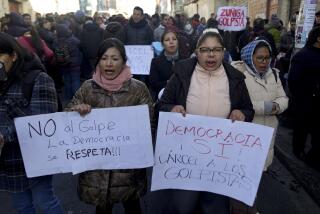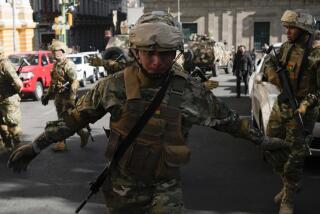Panama Coup Attempt Fails; Violence Erupts
- Share via
PANAMA CITY — Rebellious officers in Panama’s Defense Forces tried and failed early Wednesday to carry out a coup d’etat against military strongman Manuel A. Noriega, Panamanian military officials said.
Five accused plotters, including the military chief of Panama’s police force, were arrested, according to a military statement.
Not long after gunfire echoed through Gen. Noriega’s headquarters, troops pursued and fought with demonstrators in the most violent disturbances in Panama since the political turmoil erupted here eight months ago.
No Casualties Reported
Despite the gunfire at the headquarters building, the military insisted that no one was killed or wounded.
“The chief commander (Noriega), in a rapid action, was able to suffocate and control the situation,” the military said in a statement.
A spokesman, Maj. Edgardo Lopez, said Noriega was not present during the attempted coup. But Noriega appeared at his headquarters complex in the morning and sought to minimize the incident. The general stood at the top of an open flight of stairs in the headquarters compound and dismissed reports of trouble as groundless. He was accompanied by members of his staff, all dressed, as he was, in civilian clothing.
When a reporter shouted, “What were the gunshots?” he called back, “Kisses,” and, smiling, blew a kiss to the crowd.
The military statement said: “This morning an attempt by some officers to take and control the central headquarters of our institution, in an isolated action, was aborted. It was repressed by the firmness of the officers and troops at the installation.”
Col. Leonidas Macias, the national police chief, was identified as the apparent leader. He was said to be under arrest, along with Maj. Fernando Quezada, Maj. Aristides Valdonedo, Maj. Jaime Benitez and Capt. Humberto Macea.
Lopez, the spokesman, said: “Macias tried to fool the units in charge of security at headquarters. It was a bluff. He tried to pull rank and say he was in charge.”
Lopez said Macias was somehow under the influence of the United States. He added that the other four rebel officers had recently returned from training in the United States, but that could not be confirmed independently.
The shooting heard at the headquarters, Lopez said, consisted of “warning shots fired in the air.” He said it broke out after Macias said he was in charge and the loyal troops replied, “No, you are not.”
Purge Seen as Likely
Foreign military observers said that Noriega still appears to be in charge of the armed forces. A purge of suspect officers, they said, is likely to follow Wednesday’s failed coup.
According to the observers, the incident dispelled the myth of solid military support for Noriega and disclosed splits that have been long rumored.
Maj. Lopez said the incident involved “no more than a dozen” rebels.
In the run-down neighborhood of Chorrillo, where Noriega’s whitewashed headquarters building stands behind a turreted wall, the shooting began about 7 a.m. and lasted for roughly half an hour, witnesses said.
A score or more of soldiers moved into the streets around the headquarters building, maintaining order among a crowd that had gathered there and keeping vehicular traffic moving. Some shots were fired to disperse the crowd.
3 Reporters Detained
Three reporters were detained briefly outside the headquarters. They said later that they had seen an army captain being escorted away with his hands tied behind his back.
They said another officer told them the captain was taking part “in a simulated exercise.”
“We even simulate taking prisoners,” they quoted the officer as saying.
The incident reflected the sharply increased tension in the wake of economic and political pressures brought to bear on Noriega, from both inside and outside the country.
Public employees are not being paid their salaries this week, and according to some reports, neither are soldiers. The cash crunch has triggered three days of unrest here in the capital, where more than half of Panama’s 2.5 million people live.
Accused of Corruption
The money crisis was brought on when the Reagan Administration--which has accused Noriega of narcotics-related corruption--froze Panamanian government funds in the United States in hopes of pressuring the general to give up power.
During the general’s brief appearance at his headquarters in the morning, a reporter inquired about the government’s inability to pay public servants, Noriega responded, “Let the gringos return the money they stole!”
In other developments Wednesday, troops attacked striking electrical and dockworkers who had gathered at the intersection of Central and Arosemena avenues in Panama City’s principal commercial district.
Dozens of helmeted soldiers carrying shields, shotguns and M-16 rifles approached the demonstrators from one end of Central Avenue while plainclothes policemen--who in Panama are under military supervision--moved in from the other. The protesters took shelter behind makeshift barricades, including a large flatbed truck and a tank truck, and hurled stones at the security forces.
Soldiers Fire Birdshot
Routed, the protesters fled down side streets as the soldiers and plainclothesmen fired birdshot into the air and also into the crowd.
Earlier in the day, a youth had been wounded by gunfire, and the demonstrators thought a sniper was concealed in a building on Central Avenue. They set the building afire, and the building continued to smolder throughout the afternoon.
As the demonstrators scattered, they upset trash cans and set fire to them. They threw up makeshift barriers of scrap and paving stones to block the path of pursuing troop trucks.
The cat-and-mouse activity spilled along Arosemena Avenue toward the U.S. Embassy on the waterfront. At Santo Tomas Hospital nearby, riot police, known officially as Dobermans, tossed tear gas at protesting physicians and nurses.
Barricades in Streets
In an apparently spontaneous reaction to the violence downtown, people in residential neighborhoods in and near the financial district burned trash and put up barricades of rubble in the streets, including heavily traveled Balboa Avenue on the waterfront; Via Espana, which runs through the banking district, and 50th Street, which has become a frequent site of anti-Noriega demonstrations.
U.S. Armed Forces Radio reported that several roads leading to the Panama Canal were blocked by ship cargo containers put in place by striking dock workers. The U.S. Southern Command, which oversees the 10,000 American troops based along the canal, ordered troops not to go into Panama City or Colon, which is situated on the Caribbean coast, except on official business--and then not in uniform.
The canal, which is operated jointly by Panama and the United States, was operating normally, spokesmen at the Panama Canal Commission said.
Electricity Shut Off
There were reports of violence in Colon but these could not be immediately confirmed. Telephone lines were jammed, and it was difficult to make calls within Panama. Electricity in Panama City was shut off.
The demonstrators in downtown Panama City gave two reasons for their action: to demand their paychecks and to get Noriega out of power. They milled around under a hot morning sun among government electrical repair trucks. Many were armed with sticks, lengths of electrical cable and wrenches.
“They have not paid us!” shouted Tomas Betancourt, 60, a security guard for the striking electrical workers’ union. “It’s Noriega’s fault! Get him out!”
Geraldo Algandona, 28, an electrical technician, said: “We will be here until a solution is found. ‘The Pineapple’ must be brought down.”
“Pineapple” is an insulting nickname for Noriega, whose face is pockmarked with old acne scars.
Soldiers on Patrol
As night fell, smoke drifted through Panama City’s downtown, and soldiers patrolled most main streets throughout the capital. Police were seen arresting youths on Central Avenue at dusk.
It seems unlikely that the city can return to normal soon. Schools have been closed indefinitely. Banks, which have been closed, are not expected to reopen this week. With the electrical workers on strike, there is no indication when power may be restored. In Washington, meanwhile, U.S. government and oil company officials said the electrical workers’ strike has cut off power to the Panama pipeline carrying Alaskan oil bound for the U.S. Gulf Coast, halting the flow of oil through the 81-mile line.
The interruption of electrical power to a pumping station on the pipeline could eventually force the oil companies to use costly and time-consuming alternatives to transport the 700,000 barrels of crude that moves through the line each day.
Cutoff Called Temporary
However, both the U.S. Department of Energy and the companies involved--the pipeline owners and the oil companies, chiefly British Petroleum and Exxon--initially viewed the cutoff of power as a temporary and inadvertent result of the strike.
Although oil stopped flowing through the pipeline at mid-afternoon, storage tanks at the west and east ends of the line can hold 2.5 million barrels each. Officials said there was no immediate effect on incoming or outgoing tanker traffic.
Times staff writer Donald Woutat in Washington contributed to this article.
More to Read
Sign up for Essential California
The most important California stories and recommendations in your inbox every morning.
You may occasionally receive promotional content from the Los Angeles Times.













